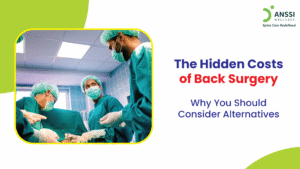Cervical spondylosis is a common age-related condition that affects the neck, often leading to persistent neck pain and stiffness. As the bones, discs, and joints of the cervical spine undergo natural wear and tear over time, many individuals experience discomfort that can interfere with daily life.
While it is especially prevalent in older adults, lifestyle factors have contributed to a rising number of younger individuals being affected as well.
What is Cervical Spondylosis?
Cervical spondylosis refers to the degeneration of the structures in the cervical spine, including the intervertebral discs, vertebrae, and ligaments. These changes can result in reduced disc height, bone spurs (osteophytes), and decreased spinal flexibility.
Although primarily linked to ageing, younger people with poor posture or a history of neck injuries can also develop this condition. Over time, these degenerative changes can lead to nerve compression, causing pain and neurological symptoms.
Causes and Risk Factors
The primary cause of cervical spondylosis is ageing, as spinal structures naturally weaken over time. Nevertheless, a number of other elements may speed up or exacerbate the condition:
- Sedentary lifestyle: Sitting for long hours, especially with poor posture, places excessive strain on the cervical spine.
- Repetitive movements: Jobs that require frequent neck movement or looking down can contribute to early disc wear.
- Previous injuries: Trauma or injuries to the neck area can weaken spinal structures and increase susceptibility.
- Genetics: A family history of spine disorders can raise the risk.
- Smoking: Smoking reduces blood flow to spinal discs, speeding up degeneration.
- Screen time: Excessive use of mobile devices and computers, often with the head tilted forward, increases cervical stress.
People who spend extended hours at a desk, especially in non-ergonomic setups, are particularly vulnerable to developing cervical spondylosis earlier in life.
Symptoms to Watch For
Symptoms of cervical spondylosis can vary depending on the severity of degeneration and whether nerves are affected.
Common symptoms include:
- Chronic neck pain: A dull, persistent ache that may worsen with movement
- Neck stiffness: Difficulty turning or bending the neck
- Headaches: Typically originating from the base of the skull
- Shoulder pain: Pain may reach the shoulders and upper back
- Tingling or numbness: Particularly in the arms, hands, or fingers if nerves are compressed
- Muscle weakness: In severe cases, it can affect grip strength or arm mobility
- Limited range of motion: Difficulty performing normal neck movements
If the condition progresses to cause spinal cord compression (a condition known as cervical myelopathy), symptoms can become more serious, including balance issues or loss of bladder/bowel control. Such cases require prompt medical evaluation.
Non-Surgical Treatment Options
Fortunately, many individuals with cervical spondylosis can manage their symptoms effectively with conservative, non-surgical treatments. These approaches aim to relieve pain, reduce inflammation, improve mobility, and prevent further damage.
Physiotherapy
Targeted physical therapy exercises can help strengthen neck muscles, improve posture, and increase flexibility. A trained physiotherapist can develop a personalised plan to support spinal health.
Posture Correction
Adopting and maintaining proper posture, especially while sitting at a desk or using digital devices, significantly reduces strain on the cervical spine. Ergonomic assessments and posture training can help individuals avoid harmful habits.
Non-Surgical Spinal Decompression Treatment
Non-surgical spinal decompression is an advanced treatment that gently stretches the spine to relieve pressure on spinal discs and nerves. This procedure is especially effective for conditions like herniated discs, bulging discs, and nerve impingement associated with cervical spondylosis.
Lifestyle Modifications
- Regular movement: Avoid prolonged sitting. Take short breaks every hour to stretch and walk.
- Exercise: Engage in low-impact activities such as walking or swimming to keep the spine flexible.
- Anti-inflammatory diet: Foods rich in omega-3s, antioxidants, and calcium support spinal health.
- Sleep habits: Use a supportive pillow and maintain a good sleeping posture to reduce neck strain.
Ergonomic Adjustments
Workstations should be set up to reduce strain on the neck and shoulders. Computer screens should be at eye level, chairs should support the lower back, and keyboards should be positioned to avoid forward-leaning posture.
Pain Management
In some cases, short-term use of anti-inflammatory medications or muscle relaxants may be advised. However, these should be used under medical supervision and not as a long-term solution.
Heat and Cold Therapy
Applying heat can relax tense muscles, while cold packs can reduce inflammation after physical activity or flare-ups.
About ANSSI:
ANSSI Wellness focuses on improving the quality of life for patients suffering from spinal issues, aiming to provide relief where other conventional treatments have failed. Through advanced non-surgical spinal decompression treatment, ANSSI is committed to helping patients avoid surgery and recover in a safe, effective, and compassionate environment.
Connect with ANSSI Wellness on LinkedIn, Instagram, and Facebook for expert guidance.



